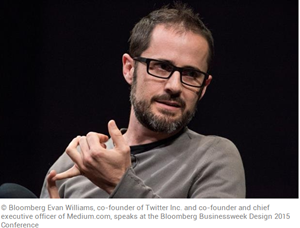Can Medium Transform Failing Ad-driven Online Media?
Last week, Medium laid off 50 employees in non-engineering roles which made up about one-third of the staff and is shutting down its offices in New York and Washington, D.C, in an effort to utilize its resources to build a yet-to-be-announced new business model that will reward writers and creators based on the value they’re creating for people.
 While 2016 was Medium's "best year yet", with readers and published posts growing 300% year on year, why did the company make such a drastic decision? In his blog post, its Chief Executive Officer Ev Williams, also co-founder of Twitter, wrote: “Obviously, this is a tough thing to do, made tougher by the immense respect and love we have for these people who have helped make Medium what it is today. We reached this decision when Medium’s management team came together to review the last year and take a hard look at our business - where we are and
While 2016 was Medium's "best year yet", with readers and published posts growing 300% year on year, why did the company make such a drastic decision? In his blog post, its Chief Executive Officer Ev Williams, also co-founder of Twitter, wrote: “Obviously, this is a tough thing to do, made tougher by the immense respect and love we have for these people who have helped make Medium what it is today. We reached this decision when Medium’s management team came together to review the last year and take a hard look at our business - where we are and
where we’re headed. While we could continue on our
current path - and there is a business case for doing so - we decided that we risk failing on our larger, original mission if we don’t make some proactive changes while we have the momentum and resources to do so.”
First things first, what was that original mission? In 2012, Medium set out to build a better publishing platform than the others and change the “broken system” which is ad-driven media on the internet according to Williams. However, over time, the well-funded startup has become an extension of that broken system. Where the system breaks is that the vast majority of any form of content people consume is paid by corporations who manipulate the system in order to tackle their business goals. As a result, instead of focusing on stories filled with quality information that make people smarter, content creators are forced to focus on reach and page views by publications that aim to gain advertising revenue.
The Evolution of Medium
To understand William’s emotional argument behind Medium’s shift in strategy, let’s briefly look at the evaluation that the company has gone through and how its business model has been shaped over the years. When the business was first rolled out, in his post, William explained: “Medium is a new place on the Internet where people share ideas and stories that are longer than 140 characters and not just for friends.” In 2013, it acquired Matter, the science and technology journalism startup and from there, it began publishing some magazine-style verticals with paid staff writers. As the website grew, it began a native advertising business. In 2014, Medium started publishing Re:form, a collection of posts about design edited by Sarah Rich, a former senior editor at Dwell magazine. What made Re:form a milestone in Medium’s evolution is that BMW fully sponsored it for six months. During that time, "Presented by BMW" displayed near the top of the page, with BMW videos running at the bottom of every article. Medium staff produced four to five articles, which were marked as sponsored and published through BMW's profile on Medium, about the automaker that will run on the publication. "We're in the exploratory moment," said Evan Hansen, a senior editor at Medium. "It's not about the money, it's about the experiment."
The ways the company was paying for the writers varied. Some writers were rewarded with bonuses depending on pageviews and clicks their content scored. Lastly, last March, Medium announced that its in-house publication Matter was being spun off as a standalone entity, and will be pivoting from a long-form science magazine into a kind of media incubator/laboratory called Matter Studios. It also created the revenue beta program to enable publications on Medium’s platform to generate revenue. Under this program, content creators were able to sell subscriptions to readers and gain a margin from Medium’s native advertising revenue. Medium involved 30 publishers to the program.
So, according to William, Medium could have continued further down the ad-supported path, but by doing so would have made it an extension of a dying business model that creates nothing innovative or different.
It is ambiguous how this decision will impact Medium's valuation in the future, considering the company has raised more than $130 million in venture capital since its launch and attracted high-profile Silicon Valley investors, including Greylock and Andreessen Horowitz.
What Others Think
Elizabeth Spiers, whose There Is Only R was also part of Medium’s revenue beta for publishers, commented  on the news that wasn’t officially discussed with them:
on the news that wasn’t officially discussed with them:
“I’ll admit I’m baffled when the stated rationale for throwing in the towel is that ad-backed media is broken. If we agree that it is, it was broken when Medium began the publisher program and had they listened to any people who’ve been publishers before (many of the publishers in their revenue program, for example), that would have been obvious. So I agree with Bryan Goldberg here when he says that you generally have to understand an industry before you try to disrupt it, and too many Valley companies intent on fixing broken models think incumbent companies are using broken models because they’re idiots and not because the problems are not easily solved.”

A very ironic reaction came from The Establishment, a year-old site, which was set to announce it had transitioned to Medium on the day this announcement came. “This is not the announcement post we had planned to publish today,” co-founder Kelley Calkins wrote:
"Medium initially approached us about a possible migration over the summer. We have been in the process of migrating our site from WordPress to Medium since late fall, excited to join the ranks of publishers we admire—ThinkProgress, The Awl, Femsplain, The Ringer, Pacific Standard, to name but a few—and the broader Medium network of talented writers and thoughtful readers alike. Our launch day, today, was scheduled in early December. We received news of Medium’s pivot and attendant downsizing when the rest of the world did, around noon. At this time, this is, literally, all we know."
Shaunna Murphy, experienced senior writer and editor, reacted on Twitter:
Medium investor M.G. Siegler, a partner at GV, Alphabet Inc.’s venture capital arm, wrote: “Medium found itself straying down the path of least resistance, where legacy models reside. At some point, there will be a fundamental recalibration of the publishing model…In the long run, this will benefit all of us.” He also suggested that the company may experiment with several ways to generate revenue for content partners by mentioning that recent online payment innovations made it considerably easier than it once was to support online transactions like micropayments.
Whereas a media thinker Jay Rosen tweeted this:
What I think
2 billion words written and 7.5 million posts published on Medium in the last year. Currently, it has 60 million monthly readers. In my opinion, his decision to get back on the road that Medium initially set out upon instead of getting caught up in very impressive numbers is laudable and not something many business owners could undertake. Being a content creator, it is hard to disagree with him about the ad-driven business model’s unfavorable impact on content, where the only thing that matters is if a web page stayed open enough to make money. Not to mention social media shares where people keep posting links to articles which they actually have never read beyond the headlines. On the other hand, the quality-driven content can be created only when authors are well-paid so they can focus and spend much more time on their research, and other components that create their compelling stories. Bearing this in mind, the idea of developing a publishing platform where highly skilled people can pour out their knowledge almost for free, but generates revenue for the business owners is basically a fantasy. Therefore, I’m sincerely excited about the new yet-to-be-developed business model which is measurable, profitable and appreciates the quality of work at the same time.

Venus Tamturk
Venus is the Media Reporter for CMS-Connected, with one of her tasks to write thorough articles by creating the most up-to-date and engaging content using B2B digital marketing. She enjoys increasing brand equity and conversion through the strategic use of social media channels and integrated media marketing plans.